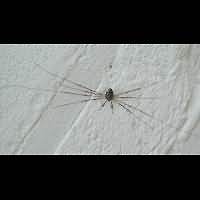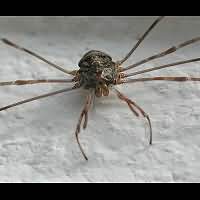Dicranopalpus ramosus
Dicranopalpus ramosus is a harvestman everyone is capable of identifing, especially when it is resting. The animal sits flat on the surface of a wall, fence or trunk of a tree. All legs are spread out along and very close to each other to the sides. The enormous and forked palps are stretched out forward in full. In this position the animal can spend the entire day. But even when it is walking the enormous forked pedipalps are extremely impressing. The animal even seems to be in possession of 10 in stead of 8 legs. The ground colour of this species is greyish brown. In most parts of Western Europe this is the only harvestmen showing forked palps. In the Alps however a second such species may be encountered, the very closely related Dicranopalpus gasteinensis. The males reach a length of some 3 to 4mm. The females are bigger and reach a bodily length of some 4 to 6mm.
Dicranopalpus ramosus has been discovered as a species in 1904 in Marocco. It was absent from Europe by then. After its discovery it rapidly spread northwards into Europe. In 1948 it was seen in Portugal. Less than 10 years later it was discovered in Britain (Bournemouth, 1957). The spreading went on northwards and eastwards. Spain was reached by 1965, France followed in 1969. By 1994 the Netherlands were reached. Still it took the animal until 2004 to reach Germany. In Britain Scotland was invaded in 2000. The spreading is much like the Red Harvestman's, but a lot slower. Yet there is little doubt Eastern Europe will be conquered as well.
Dicranopalpus ramosus is a common species all over Britain nowadays. One thing should be kept in mind though: due to the curious way of resting everybody is capable of identifying this animal, so information about its spreading is quite plentiful. Many other harvestmen need close inspection to establish the identity. Information about their presence is much more unreliable. Dicranopalpus ramosus is a rather late species, for adults do not often appear before mid-August. When conditions are good they keep on sleeping on your wall till November.
Dicranopalpus ramosus is a harvestman everyone is capable of identifing, especially when it is resting. The animal sits flat on the surface of a wall, fence or trunk of a tree. All legs are spread out along and very close to each other to the sides. The enormous and forked palps are stretched out forward in full. In this position the animal can spend the entire day. But even when it is walking the enormous forked pedipalps are extremely impressing. The animal even seems to be in possession of 10 in stead of 8 legs. The ground colour of this species is greyish brown. In most parts of Western Europe this is the only harvestmen showing forked palps. In the Alps however a second such species may be encountered, the very closely related Dicranopalpus gasteinensis. The males reach a length of some 3 to 4mm. The females are bigger and reach a bodily length of some 4 to 6mm.
Dicranopalpus ramosus has been discovered as a species in 1904 in Marocco. It was absent from Europe by then. After its discovery it rapidly spread northwards into Europe. In 1948 it was seen in Portugal. Less than 10 years later it was discovered in Britain (Bournemouth, 1957). The spreading went on northwards and eastwards. Spain was reached by 1965, France followed in 1969. By 1994 the Netherlands were reached. Still it took the animal until 2004 to reach Germany. In Britain Scotland was invaded in 2000. The spreading is much like the Red Harvestman's, but a lot slower. Yet there is little doubt Eastern Europe will be conquered as well.
Dicranopalpus ramosus is a common species all over Britain nowadays. One thing should be kept in mind though: due to the curious way of resting everybody is capable of identifying this animal, so information about its spreading is quite plentiful. Many other harvestmen need close inspection to establish the identity. Information about their presence is much more unreliable. Dicranopalpus ramosus is a rather late species, for adults do not often appear before mid-August. When conditions are good they keep on sleeping on your wall till November.





